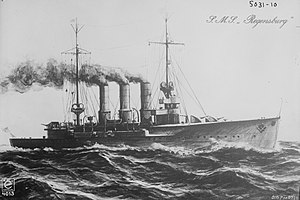Graudenz-class cruiser
 Postcard depicting a sketch of SMS Regensburg
| |
| Class overview | |
|---|---|
| Builders | Kiel Navy Yard, AG Weser |
| Operators | |
| Preceded by | Karlsruhe class |
| Succeeded by | Pillau class |
| Built | 1912–1915 |
| In commission | 1914–1944 |
| Planned | 2 |
| Completed | 2 |
| Lost | 1 |
| Retired | 1 |
| General characteristics | |
| Type | Light cruiser |
| Displacement |
|
| Length | 142.70 m (468 ft 2 in) |
| Beam | 13.80 m (45 ft 3 in) |
| Draft | 5.75 m (18 ft 10 in) |
| Installed power |
|
| Propulsion |
|
| Speed | 27.5 kn (50.9 km/h; 31.6 mph) |
| Range | 5,500 nmi (10,200 km; 6,300 mi) at 12 knots (22 km/h; 14 mph) |
| Crew |
|
| Armament |
|
| Armor |
|
The Graudenz class of light cruisers was a class of two ships built for the Imperial German Navy. The class comprised SMS Graudenz and SMS Regensburg. The ships both were laid down in 1912, launched in October 1913 and April 1914 and commissioned in August 1914 and January 1915, respectively. They were armed with a main battery of twelve 10.5 cm (4.1 in) guns, though over the course of their careers, they were rearmed with seven more powerful 15 cm (5.9 in) guns. They displaced 6,382 t (6,281 long tons) at full load and were rated at a top speed of 27.5 knots (50.9 km/h; 31.6 mph)
Both ships saw extensive service during
Design
General characteristics and machinery

The ships of the Graudenz class were 139 meters (456 ft)
The two vessels each had a standard crew of twenty-one officers and 364 enlisted men. While serving as a second command flagship or a flotilla leader, they had an additional three officers and fourteen enlisted men for the commander's staff. They carried a number of smaller boats, including one picket boat, one barge, one cutter, two yawls, and two dinghies. The German Navy regarded the ships as good sea boats, with slight weather helm and gentle motion in a swell. The cruisers were maneuverable, but were slow going into a turn. Steering was controlled by a single large rudder. They lost speed only slightly in a head sea, but lost up to sixty percent in hard turns. They had a transverse metacentric height of .79 m (2 ft 7 in).[2]
The ships' propulsion system consisted of two sets of Marine-type
Armament and armor
The ships were armed with twelve
The ships were protected by a waterline
Service history
Graudenz
Graudenz saw extensive service during World War I, including serving as part of the reconnaissance screen for the
Regensburg
Regensburg served in the reconnaissance forces of the High Seas Fleet during World War I.
Footnotes
- ^ a b c Gröner, pp. 109–110.
- ^ a b Gröner, p. 109.
- ^ Campbell & Sieche, pp. 140, 160.
- ^ Tarrant, pp. 31, 36.
- ^ Halpern, p. 197.
- ^ Campbell, p. 23.
- ^ Woodward, pp. 115–116.
- ^ Tarrant, p. 282.
- ^ Fraccaroli, p. 264.
- ^ Gröner, p. 110.
- ^ Tarrant, p. 62.
- ^ Woodward, pp. 118–119, 165–166.
- ^ a b Smigielski, p. 201.
- ^ The Daily News Almanac and Political Register, p. 443
References
- Campbell, John (1998). Jutland: An Analysis of the Fighting. London: Conway Maritime Press. ISBN 978-1-55821-759-1.
- Campbell, N. J. M. & Sieche, Erwin (1986). "Germany". In Gardiner, Robert & Gray, Randal (eds.). Conway's All the World's Fighting Ships 1906–1921. London: Conway Maritime Press. pp. 134–189. ISBN 978-0-85177-245-5.
- Fraccaroli, Aldo (1986). "Italy". In Gardiner, Robert & Gray, Randal (eds.). Conway's All the World's Fighting Ships 1906–1921. London: Conway Maritime Press. pp. 252–290. ISBN 978-0-85177-245-5.
- ISBN 978-0-87021-790-6.
- Halpern, Paul G. (1995). A Naval History of World War I. Annapolis: Naval Institute Press. ISBN 978-1-55750-352-7.
- Smigielski, Adam (1985). "France". In Gardiner, Robert & Gray, Randal (eds.). Conway's All the World's Fighting Ships 1906–1921. Annapolis: Naval Institute Press. pp. 190–220. ISBN 978-0-87021-907-8.
- Tarrant, V. E. (1995). Jutland: The German Perspective. London: Cassell Military Paperbacks. ISBN 978-0-304-35848-9.
- Woodward, David (1973). The Collapse of Power: Mutiny in the High Seas Fleet. London: Arthur Barker Ltd. ISBN 978-0-213-16431-7.
- The Daily News Almanac and Political Register. 45. Chicago: Chicago Daily News Co. 1929. )
Further reading
- Dodson, Aidan; Cant, Serena (2020). Spoils of War: The Fate of Enemy Fleets after the Two World Wars. Barnsley: Seaforth Publishing. ISBN 978-1-5267-4198-1.
- ISBN 978-1-68247-745-8.
- Koop, Gerhard & Schmolke, Klaus-Peter (2004). Kleine Kreuzer 1903–1918: Bremen bis Cöln-Klasse [Small Cruisers 1903–1918: The Bremen Through Cöln Classes] (in German). München: Bernard & Graefe Verlag. ISBN 3-7637-6252-3.
- Nottlemann, Dirk (2021). "The Development of the Small Cruiser in the Imperial German Navy (Part II)". In Jordan, John (ed.). Warship 2021. Oxford, UK: Osprey Publishing. pp. 44–60. ISBN 978-1-4728-4779-9.
